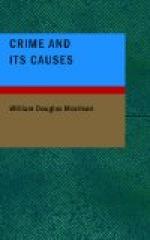Proportion of working class to total population 90
p. ct.
Proportion, of prisoners from this class 82
p. ct.
Proportion of well-to-do to population 10
p. ct.
Proportion of prisoners from this class
6 p. ct.
Numbers of criminal class, say 60,000
Proportion of prisoners from this class 12
p. ct.
According to these figures, the well-to-do contribute less than their proper proportion to the prison population. This arises, as has already been stated, from the fact that this class has so many more facilities for escaping the penalty of imprisonment; the difference would be adjusted if the cases tried before the criminal courts were taken as a standard. An examination of these cases would undoubtedly show that each class was represented in proportion to its numbers.
According to Garofalo, one of the most learned of Italian jurists, the poor people in Italy commit fewer offences against property, in proportion to their numbers, than the well-to-do, while in Prussia persons engaged in the liberal professions contribute twice their proper share to the criminal population. A somewhat similar state of things exists in France; there the number of persons engaged in the liberal professions forms four per cent. of the population; but, according to the investigations of Ferri, in his striking little book, “Socialismo e Criminalita,” the liberal professions were responsible for no less than seven per cent. of the murders perpetrated in France in 1879.
What is the period of the year we should expect most crime to be committed if poverty is at the root of it? In this country, at least, it is very well known that the labouring classes are apt to suffer most in the depth of winter, and the depth of winter may be said to correspond with the months of December, January, and February. It is in these months that all outdoor occupations come to a comparative standstill; it is then that the poorest section of the population—the men without a trade, the men who live by mere manual labour—are reduced to the greatest straits. In the winter months some of these men have to pass through a period of real hardship; the state of the weather often puts an absolute stop to all outdoor occupations, and when this is the case, it takes an outdoor labourer all his might to provide the barest necessaries for his home. In addition to this difficulty, which lies in the nature of his calling, a labourer finds the expense of living a good deal higher in the depth of winter. He has to burn more fuel, he has to supply his children with warmer clothing, in a variety of ways his expenses increase, notwithstanding the most rigid economy. Winter is not only a harder season for the outdoor labourer, it is a time of greater economic trial for the whole working-class population. This, I think, is a statement which will be universally admitted.




